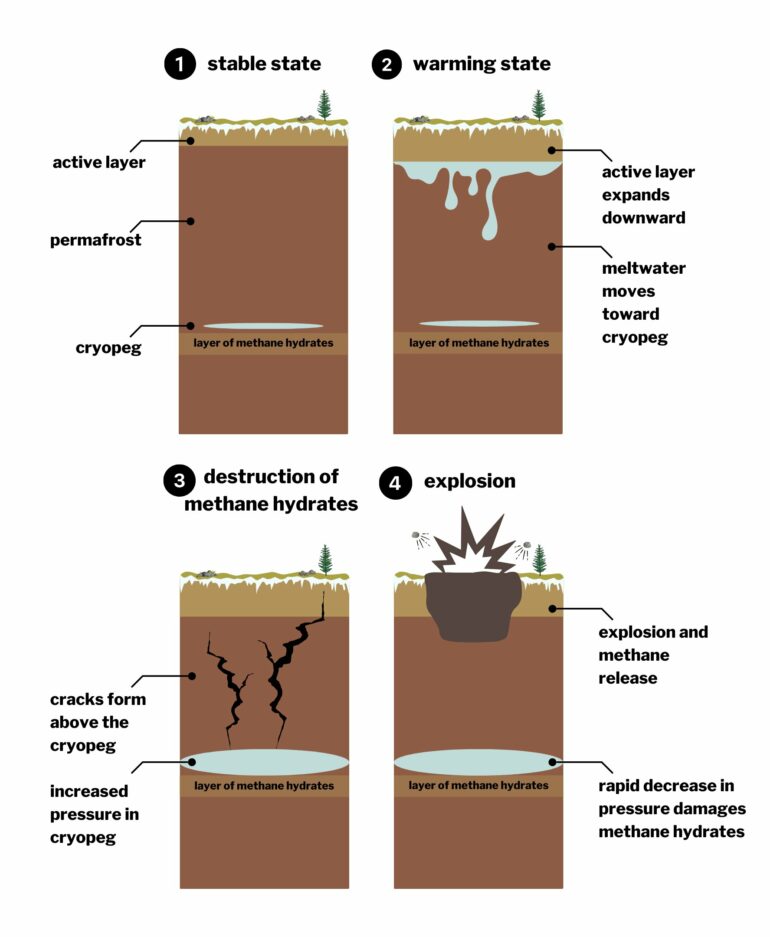Mysterious craters that first appeared in the Siberian permafrost a decade ago were caused by climate change-driven pressure changes that explosively released methane frozen underground, a new study reports. The research offers a fresh take on the origins of the craters first sighted on Russia’s Yamal Peninsula in 2014.
The new study finds that the region’s unusual geology, coupled with climate warming, kickstarted a process that led to the release of methane gas from methane hydrates in the permafrost.
“There are very, very specific conditions that allow for this phenomenon to happen,” said Ana Morgado, a chemical engineer at the University of Cambridge and one of the study’s authors. “We’re talking about a very niche geological space.”
The research was published in Geophysical Research Letters.
The case of the exploding permafrost
The Yamal Peninsula is a low-lying land mass that juts into the Kara Sea from north-central Russia. In 2014, reports emerged of a crater, approximately 70 meters (230 feet) across at its widest point, that appeared suddenly in the permafrost. Over the ensuing decade, other craters have been found on both the Yamal Peninsula and the nearby Gydan Peninsula.
Many explanations for the craters have emerged over the last 10 years, attributing the explosions to a buildup of methane gas underground due to permafrost melt, or to the craters’ proximities to natural gas reserves.
But the authors found that permafrost warming alone would not be enough to cause an explosion. The new explanation says that surface warming leads to a rapid pressure change deep underground, causing the release of explosive methane gas.
“We knew that something was causing the methane hydrate layer to decompose,” Morgado said. “It’s a bit like detective work.”
Osmosis drives explosions
The researchers solved the puzzle from the bottom up, first considering a basic question: Were the explosions caused by physical or chemical processes?
“There are only two ways you can get an explosion,” said Julyan Cartwright, a geophysicist at the Spanish National Research Council and one of the study’s authors. “Either a chemical reaction happens, and you have an explosion, like dynamite blowing up, or you pump up your bicycle tire until it blows up—that’s physics.”
In this case, he said, there was no evidence that the explosions were caused by chemical reactions, so they must have had a physical source. “And then you have to think, what’s the pump that’s pumping up your bicycle tire?” he said.
The authors say the pump was osmosis, which is how a fluid moves to equalize the concentration of substances dissolved in it. Salty water is a classic example. If a barrier exists that will allow water to pass, but not salt, pressure may build on the salty side as water flows to it.
The Yamal Peninsula’s thick, clayey permafrost acts as an osmotic barrier—and warming is changing it. This 180 to 300-meter (590 to 980-foot)-thick layer stays permanently frozen throughout the year. An “active layer” of topsoil above it thaws and re-freezes seasonally.
Interspersed throughout the tundra and sandwiched within the permafrost lie unusual, one-meter-thick layers of unfrozen, high-salinity water called crypogegs, kept liquid by a combination of pressure and salinity. Underneath the cryopegs sits a layer of crystallized methane-water solids, called methane hydrates, which are kept stable by high pressure and low temperature.
But warmer temperatures are destabilizing these layers. Climate change has caused the active layer to melt and expand downward until it reaches the cryopeg, releasing water that travels via osmotic pressure into the cryopeg, the researchers found.
But there isn’t enough space in the cryopeg to hold the extra meltwater forced in by osmosis, so pressure builds. The increasing pressure creates cracks in the soil that travel upward from the cryopeg toward the surface. The pressure gradient then reverses: the cracked soil causes a sudden drop in pressure at depth. That pressure change damages the methane hydrates below the cryopeg, which causes a release of methane gas and a physical explosion.
The lead-up to the explosion can last for decades, the study found. That timeline aligns with increasing climate warming starting in the 1980s.
The new explanation hinges on how climate warming and the region’s geology interact to create the explosions, which are unique to the Yamal Peninsula.
“This might be a very infrequently occurring phenomenon,” Morgado said. “But the amount of methane that’s being released could have quite a big impact on global warming.”
More information:
Ana M. O. Morgado et al, Osmosis Drives Explosions and Methane Release in Siberian Permafrost, Geophysical Research Letters (2024). DOI: 10.1029/2024GL108987
Provided by
American Geophysical Union
Citation:
Study offers new explanation for Siberia’s permafrost craters (2024, September 26)



